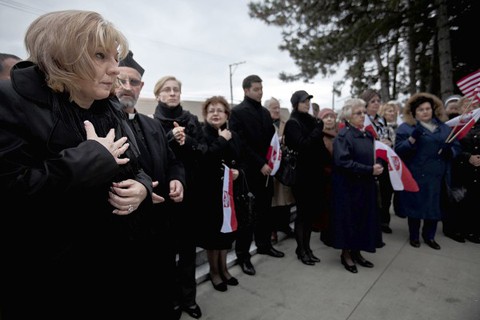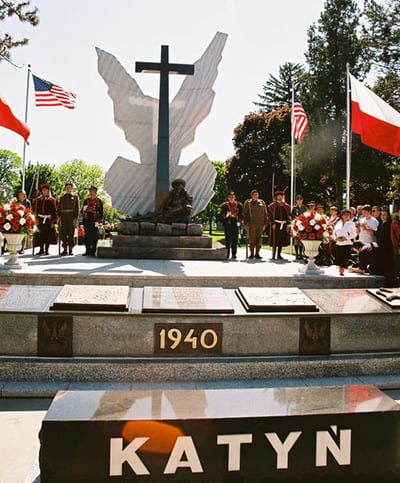

Anna Wojtowicz, left, daughter of Wojciech Seweryn, who died in the plane crash in 2010 participates in a prayer service at the monument to victims of the 1940 Katyn massacre at St. Adalbert’s Cemetery in Niles. (Zbigniew Bzdak, Chicago Tribune / April 4, 2011)
By Angie Leventis Lourgos, Tribune reporter
April 9, 2011
The artist was overjoyed as he boarded a jet bound for the forest of death.
Wojciech Seweryn, a guest of Polish President Lech Kaczynski, was honored for dedicating his life to commemorating the massacre of some 20,000 Polish officers in the Katyn Forest of Russia in 1940. One of those men was Seweryn’s father.
„Never forget,” Seweryn would say to family and friends. „You can forgive, but never forget.”
Last April 10, the Chicago artist flew with 95 other dignitaries — top military leaders, politicians and intellectuals — headed to a 70th anniversary memorial at the mass grave site that was for decades a dark Soviet-era secret.
His relatives back home in Chicago privately hoped the ceremony would give him peace, perhaps putting to rest this obsession with the forest that took his father.
But as the Tupolev TU-154 crossed the Russian border and flew into Smolensk, a thick and ominous fog swirled around the plane. The artist would never make it to Katyn.
And instead of peace, the forest fostered a new legacy of misery and suspicion.
Born with the war
Seweryn was born in Tarnow on Sept. 1, 1939, the day Germany invaded Poland, thrusting his country into World War II.
His mother’s screams of labor were muffled by the thuds of bombs outside the hospital; family members said she begged the nurses to change her son’s birth certificate to Aug. 31, so his birthday wouldn’t forever conjure memories of war.
Seweryn’s father held his only child for about an hour before returning to his reserve unit to fight. This was the last time the father and son would be together.
Dad was soon captured by the Soviets. In April and May of 1940, the NKVD, the Soviet secret police, shipped him and his fellow officers to a wooded area a short distance from Smolensk, Russia.
„In this clearing, near the edge of common graves dug deep in dry, sandy soil, death was swiftly dispensed with assembly-line efficiency,” wrote historian Allen Paul in „Katyn: The Untold Story of Stalin’s Polish Massacre.” „Forced to their knees near the edge of the pits, the Polish officers were quickly shot behind the head at close range. …”
Paul wrote that the NKVD then planted birch trees atop the graves to conceal the crime. As many as 22,000 were killed — doctors, lawyers, teachers, priests and other civic leaders — all victims of what many historians believe was Soviet leader Josef Stalin’s larger plan to eradicate the Polish elite.
The Soviet Union denied responsibility for decades and blamed the atrocity on the Germans. But even under Communist rule, the Poles whispered the truth.
An artist obsessed
From childhood, Seweryn was consumed with the memory of the father he never knew.
He immigrated to Chicago at 35, but his thoughts often drifted back to that forest, even after former Soviet leader Mikhail Gorbachev finally acknowledged his nation’s blame in 1990.
„He was obsessed,” said his daughter, Anna Wojtowicz of Mount Prospect. „He was here among us, but he lived there.”
Seweryn, a sculptor, poured his pain into his work. He spent years designing, raising money for, and building a monument to honor the massacre victims: The cross and statue of the Virgin Mary holding a murdered Polish officer was dedicated at St. Adalbert Cemetery in Niles in May 2009.
Eleven months later, the proud and joyful artist stepped on that plane with the president, his reward for never forgetting.
(PN) Wojciech Seweryn, a founder of Monument to the Victims of Katyn at St. Adalbert Catholic Cemetery in Niles, which he called „a testament of his life. „ May 17, 2009. Photo: PN- Teresa B.Buckner
A stunning disaster
A thousand or so mourners gathered at the Katyn grave site awaiting the outdoor
Mass. They sat behind rows of empty chairs with nameplates prepared for the president and his fellow dignitaries. The guests of honor never arrived.
Janek Pospieszalski, a journalist covering the ceremony for a Polish public access television station, remembers a random man with a cellphone at his ear running and screaming that the plane had crashed as it neared Smolensk.
„Some people were crying, other people just simply had their heads in their hands,” Pospieszalski said, through an interpreter. „They were in shock. A lot of people were trying to call the people that were on the plane themselves, on their cellphones. Because these were their friends, these were their family.”
Then a young priest went up front and began to pray. Slowly, everyone in the crowd put down their cellphones, picked up their rosaries and prayed along with him in Polish, Pospieszalski said.
The news trickled in: President Kaczynski was dead. And no one survived.
Even as Seweryn’s relatives in Chicago battled grief, they acknowledged how eerily fitting it was for him to die just a few miles from the grave of his father.
„I think this was the way for him to go,” said his daughter, through tears. „On the same soil where his father died.”
Russian investigators in January blamed the crash on Polish pilots, who they say were pressured to land in the dangerous fog by their higher-ups, including an intoxicated military commander; but Polish officials have countered that poor signals from Russian air traffic controllers — as well as lack of proper navigation equipment at the military airport — also led to the catastrophe, the Associated Press reported. Polish investigators have not released their report yet.
Wojtowicz and other Poles here and abroad remain highly suspicious of the crash circumstances. As thousands of Polish-Americans celebrated special Masses and concerts here throughout last week to commemorate the anniversary, many shared their fears and historical distrust of Russia, as well as their inability to let go.
„If this was really an accident, we want to know how it happened, because there were so many lies,” Wojtowicz said. „Everything was such a mess, plus the weather, that nobody knows what had happened.”
She spent her youth wondering why her father remained so tormented by Katyn. Now she spends her days urging others to petition members of the U.S. Congress, desperately hoping they’ll call for an international investigation of the plane crash.
She talks to Polish newspapers and radio shows, voicing her criticisms. She notes that Russia had first access to the evidence, that some believe the Russian air traffic controllers gave the crew erroneous information, and that witnesses complained that the crash site wasn’t cordoned off properly.
Wojtowicz went back to Poland in the fall, pushing prosecutors there until they would let her review available crash reports. She spent five hours searching through gruesome photos and documents, but found no resolution.
„First my father became obsessed with Katyn,” she said. „And I’m so afraid I’m going to be obsessed with this tragedy.”
Stopping at cemetery
Wojtowicz visited her father’s grave in Poland in November on All Souls’ Day.
While leaving flowers at his headstone, she saw her elementary school principal — a reminder of dark times under communism.
When she was growing up in Poland, everyone feared the Soviets. Children could talk about their relatives killed while fighting the Germans; no one could mention the Soviets or Katyn.
But a 10-year-old Wojtowicz once proudly told her class that her grandfather fought for Poland and was killed in Katyn by the NKVD.
That principal yelled at her and shook her violently, telling her to keep quiet.
„This thing is so stuck in my head,” she said. „And emotionally, he kind of broke me that day.”
But at the cemetery, the principal was frail and old, her father’s age. He wept as he apologized for the past.
„He said, you know, times were different then. Blah, blah, blah,” she said.
Wojtowicz says she made peace with him.
„I forgive you,” she told the principal. „I’m not going to forget, but I forgive.”
Source:
